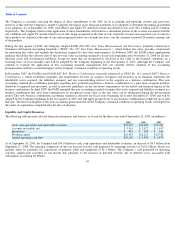Apple 2009 Annual Report Download - page 43
Download and view the complete annual report
Please find page 43 of the 2009 Apple annual report below. You can navigate through the pages in the report by either clicking on the pages listed below, or by using the keyword search tool below to find specific information within the annual report.
Table of Contents
Income Taxes
The Company records a tax provision for the anticipated tax consequences of the reported results of operations. In accordance with GAAP, the
provision for income taxes is computed using the asset and liability method, under which deferred tax assets and liabilities are recognized for the
expected future tax consequences of temporary differences between the financial reporting and tax bases of assets and liabilities, and for
operating losses and tax credit carryforwards. Deferred tax assets and liabilities are measured using the currently enacted tax rates that apply to
taxable income in effect for the years in which those tax assets are expected to be realized or settled. The Company records a valuation
allowance to reduce deferred tax assets to the amount that is believed more likely than not to be realized.
The Company recognizes and measures uncertain tax positions in accordance with GAAP, whereby the Company only recognizes the tax benefit
from an uncertain tax position if it is more likely than not that the tax position will be sustained on examination by the taxing authorities, based
on the technical merits of the position. The tax benefits recognized in the financial statements from such positions are then measured based on
the largest benefit that has a greater than 50% likelihood of being realized upon ultimate settlement.
Management believes it is more likely than not that forecasted income, including income that may be generated as a result of certain tax planning
strategies, together with the tax effects of the deferred tax liabilities, will be sufficient to fully recover the remaining deferred tax assets. In the
event that the Company determines all or part of the net deferred tax assets are not realizable in the future, the Company will make an adjustment
to the valuation allowance that would be charged to earnings in the period such determination is made. In addition, the calculation of tax
liabilities involves significant judgment in estimating the impact of uncertainties in the application of GAAP and complex tax laws. Resolution
of these uncertainties in a manner inconsistent with management’s expectations could have a material impact on the Company’
s financial
condition and operating results.
Legal and Other Contingencies
As discussed in Part I, Item 3 of this Form 10-K under the heading “Legal Proceedings” and in Note 8, “Commitments and Contingencies”
in
Notes to Consolidated Financial Statements, the Company is subject to various legal proceedings and claims that arise in the ordinary course of
business. In accordance with GAAP, the Company records a liability when it is probable that a loss has been incurred and the amount is
reasonably estimable. There is significant judgment required in both the probability determination and as to whether an exposure can be
reasonably estimated. In management’
s opinion, the Company does not have a potential liability related to any current legal proceedings and
claims that would individually or in the aggregate materially adversely affect its financial condition or operating results. However, the outcomes
of legal proceedings and claims brought against the Company are subject to significant uncertainty. Should the Company fail to prevail in any of
these legal matters or should several of these legal matters be resolved against the Company in the same reporting period, the operating results of
a particular reporting period could be materially adversely affected.
Net Sales
Fiscal years 2009, 2008 and 2007 spanned 52 weeks. An additional week is included in the first fiscal quarter approximately every six years to
realign fiscal quarters with calendar quarters.
40
























